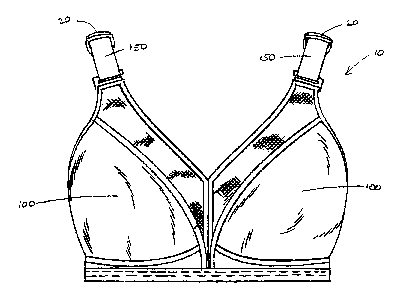Some of the information on this Web page has been provided by external sources. The Government of Canada is not responsible for the accuracy, reliability or currency of the information supplied by external sources. Users wishing to rely upon this information should consult directly with the source of the information. Content provided by external sources is not subject to official languages, privacy and accessibility requirements.
Any discrepancies in the text and image of the Claims and Abstract are due to differing posting times. Text of the Claims and Abstract are posted:
| (12) Patent Application: | (11) CA 2379520 |
|---|---|
| (54) English Title: | POSITIONABLE SHOULDER STRAP PAD FOR A BRASSIERE |
| (54) French Title: | COUSSINET DE BRETELLE DE SOUTIEN-GORGE POSITIONNABLE |
| Status: | Deemed Abandoned and Beyond the Period of Reinstatement - Pending Response to Notice of Disregarded Communication |
| (51) International Patent Classification (IPC): |
|
|---|---|
| (72) Inventors : |
|
| (73) Owners : |
|
| (71) Applicants : |
|
| (74) Agent: | EUGENE J. A. GIERCZAKGIERCZAK, EUGENE J. A. |
| (74) Associate agent: | |
| (45) Issued: | |
| (22) Filed Date: | 2002-03-28 |
| (41) Open to Public Inspection: | 2003-09-25 |
| Examination requested: | 2005-06-20 |
| Availability of licence: | N/A |
| Dedicated to the Public: | N/A |
| (25) Language of filing: | English |
| Patent Cooperation Treaty (PCT): | No |
|---|
| (30) Application Priority Data: | ||||||
|---|---|---|---|---|---|---|
|
There is provided a shoulder strap pad having a pad assembly and a fabric
cover.
The fabric cover is connected to the pad assembly along each side or axial
edge by
a binder to form an opening or channel therebetween. The shoulder strap of the
brassiere is positioned in the channel formed by the fabric cover and the pad
assembly. The shoulder strap pad is movably positionable anywhere along the
shoulder strap of the brassiere, thereby maximizing the comfort level provided
to
the wearer. The fabric cover has a first end positioned toward the front of
the
wearer and a second end positioned toward the back of the wearer. The first or
front end is cut along a diagonal on one end to provide a larger opening for
receipt
of a brassiere shoulder strap. This diagonal first end also facilitates easier
movement of the shoulder strap pad along the brassiere shoulder strap.
Note: Claims are shown in the official language in which they were submitted.
Note: Descriptions are shown in the official language in which they were submitted.

2024-08-01:As part of the Next Generation Patents (NGP) transition, the Canadian Patents Database (CPD) now contains a more detailed Event History, which replicates the Event Log of our new back-office solution.
Please note that "Inactive:" events refers to events no longer in use in our new back-office solution.
For a clearer understanding of the status of the application/patent presented on this page, the site Disclaimer , as well as the definitions for Patent , Event History , Maintenance Fee and Payment History should be consulted.
| Description | Date |
|---|---|
| Letter Sent | 2007-05-09 |
| Inactive: Office letter | 2007-05-09 |
| Inactive: Office letter | 2007-05-09 |
| Time Limit for Reversal Expired | 2007-03-28 |
| Application Not Reinstated by Deadline | 2007-03-28 |
| Deemed Abandoned - Failure to Respond to Maintenance Fee Notice | 2006-03-28 |
| Letter Sent | 2005-07-06 |
| Request for Examination Received | 2005-06-20 |
| Request for Examination Requirements Determined Compliant | 2005-06-20 |
| All Requirements for Examination Determined Compliant | 2005-06-20 |
| Inactive: Office letter | 2004-04-22 |
| Appointment of Agent Requirements Determined Compliant | 2004-04-22 |
| Revocation of Agent Requirements Determined Compliant | 2004-04-22 |
| Inactive: Office letter | 2004-04-22 |
| Revocation of Agent Request | 2004-03-29 |
| Appointment of Agent Request | 2004-03-29 |
| Application Published (Open to Public Inspection) | 2003-09-25 |
| Inactive: Cover page published | 2003-09-24 |
| Letter Sent | 2003-06-02 |
| Inactive: Single transfer | 2003-04-09 |
| Inactive: First IPC assigned | 2002-06-27 |
| Inactive: Courtesy letter - Evidence | 2002-05-07 |
| Inactive: Filing certificate - No RFE (English) | 2002-05-06 |
| Application Received - Regular National | 2002-05-06 |
| Abandonment Date | Reason | Reinstatement Date |
|---|---|---|
| 2006-03-28 |
The last payment was received on 2005-03-29
Note : If the full payment has not been received on or before the date indicated, a further fee may be required which may be one of the following
Patent fees are adjusted on the 1st of January every year. The amounts above are the current amounts if received by December 31 of the current year.
Please refer to the CIPO
Patent Fees
web page to see all current fee amounts.
| Fee Type | Anniversary Year | Due Date | Paid Date |
|---|---|---|---|
| Application fee - standard | 2002-03-28 | ||
| Registration of a document | 2003-04-09 | ||
| MF (application, 2nd anniv.) - standard | 02 | 2004-03-29 | 2004-03-29 |
| MF (application, 3rd anniv.) - standard | 03 | 2005-03-29 | 2005-03-29 |
| Request for examination - standard | 2005-06-20 | ||
| Registration of a document | 2007-03-29 |
Note: Records showing the ownership history in alphabetical order.
| Current Owners on Record |
|---|
| SARA LEE CORPORATION |
| Past Owners on Record |
|---|
| GLORIA FALLA |